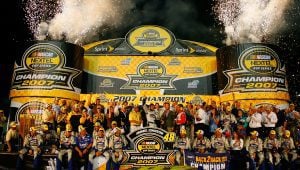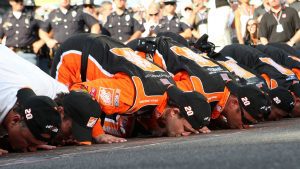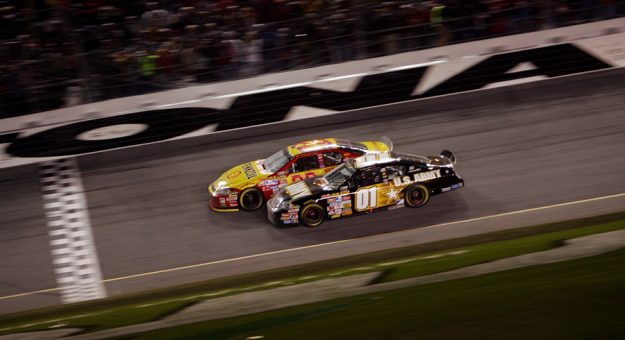Editor’s Note: NASCAR is celebrating its 75th anniversary. SPEED SPORT was founded in 1934 and was already on its way to becoming America’s Motorsports Authority when NASCAR was formed. As a result, we will bring you Part 60 of a 75-part series on the history NASCAR.
On the strength of a four-race winning streak during NASCAR’s Chase for the Championship, Jimmie Johnson and his Hendrick Motorsports team rolled to its second-consecutive championship.
Johnson drove his Chevrolet to a career-high 10 victories, the most by any driver in the series since Jeff Gordon won 13 in 1998. Johnson scored 20 top-five finishes and 24 top 10s in 36 races. He also won four poles.
Johnson fell behind early during the 10-race Chase, but consecutive victories at Martinsville (Va.) Speedway, Atlanta Motor Speedway, Texas Motor Speedway and Phoenix Raceway pushed his Lowe’s No. 48 team to the top of the heap.
“I think in the last four weeks for anyone to win four races in a row, especially with what is on the line, is pretty amazing,” Johnson said prior to his season-ending seventh-place finish at Homestead-Miami Speedway.

Hendrick Motorsports claimed 18 victories on the season, with Gordon winning six races and finishing second in the standings, while Kyle Busch and Casey Mears each won once.
The only other drivers with multiple victories were Carl Edwards and Tony Stewart, who each won three races, and Matt Kenseth and Kurt Busch who won twice each.
Kevin Harvick won the season-opening Daytona 500, beating veteran Mark Martin by a mere .020 seconds, leading Martin to say, “Nobody wants to hear a grown man cry.”
Other winners during the campaign were Jeff Burton, Martin Truex Jr., Juan Pablo Montoya, Denny Hamlin, Jamie McMurray, Clint Bowyer and Greg Biffle.
The name of the Cup Series will change for the second time in four years, as Sprint’s purchase of Nextel in 2006 has led to the series being known as the Sprint Cup Series starting in January, 2008. NASCAR’s ballyhooed Car of Tomorrow will just be the car, as the back-to-the-future style racing machine will be used in all 36 races.
The invasion of open-wheel drivers to NASCAR Cup racing will continue, with 2007 IndyCar Series champion Darto Franchitti, three-time lndyCar titlist Sam Homish Jr. and former Formula 1 world champion Jacques Villeneuve competing for the rookie of the year award in 2008.
Bill France, Jr., who led NASCAR through its growth explosion, died in June after a long fight with cancer. He was 74.

Dale Earnhardt Jr. was winless and did not qualifying for the Chase, but the third-generation driver was in the headlines for most of the season.
In May, he announced he would leave Dale Earnhardt, Inc., the team his late father founded, and would seek employment elsewhere.
After being courted by virtually every team owner in the business, Earnhardt signed with Hendrick Motorsports where he will team with Jimmie Johnson, Jeff Gordon and Casey Mears next season.
Toyota made its Nextel Cup Series debut in the Daytona 500, but for the most part the Japanese manufacturer struggled in its introduction to stock-car racing. Toyota didn’t win a race but won poles with Dave Blaney and Michael Waltrip.
Blaney was the only Toyota driver to finish in the top 35 in points.
Edwards won four times en route to winning the Busch Series championship.
